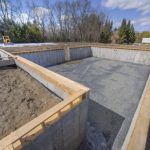 There are a series of steps that must be taken to properly install and complete a concrete foundation. If steps are skipped or your foundation is not professionally poured, the structure will show signs of instability and start to crumble.
There are a series of steps that must be taken to properly install and complete a concrete foundation. If steps are skipped or your foundation is not professionally poured, the structure will show signs of instability and start to crumble.
The foundation is the most important component to a building’s stability. A properly poured concrete foundation will remain constant and unwavering no matter how extreme weather and external conditions. A well-poured foundation will resist extreme moisture and wide-ranging temperatures from well below freezing to scorching heat. But it’s so much more than how the concrete is poured, alone.
Every stable foundation sits atop professionally excavated earth, contrary to what many may think is much more complicated than digging a trench. Say a foundation trench is dug but an excess of water is found pooling in the trench. Measures must then be taken before any concrete can be poured. This is why it’s important to enlist the services of experienced and tactical professionals.
Though you can pour concrete in up to an inch of water, if it exceeds this level, additional cobbles must be added. Tightly compacting them provide bearing for the poured wall and prevent water damage. Taking factors such as these into account will prevent foundations from sagging, cracking and separating.
Each and every patch of earth has different levels of moisture, water table levels and soil stability, each requires individual attention and design. And because no two sections of earth are the same, there are no two excavation jobs are the same. Adapting to conditions such as water tables and soil stability is the mark of an experienced excavator.
Once the excavation is complete, and any needed reinforcements are in place, you are ready to designate your foundation footers. Properly pouring a wall is as sensitive to specific conditions as is good excavating. That’s why knowing when to adjust footers accordingly is imperative to a trouble free structure. When excavating and discovering a weak spot- thanks to the presence of clay layers- special measures must be taken. These can include doubling the width of your footers or pouring extra yards of depth.
Once your footers are established, the wall or slab concrete is ready for pouring. This requires boxing out the right forms and mixing the right cement ratio. Beyond the basics, professional touches are taken by more experienced outfits, such as slotting contraction joints every 4-6 feet and including an effective drainage path. These are all professional measures do-it-yourselfers or less advanced contractors are not as privy to.
Properly grouting can make or break a solid foundation. It is literally the glue holding together the components of your foundation. Grout itself is nothing more than a mixture of water, cement, sand and fine gravel which emulsifies to ensure stability. But the proper mixing and application technique is the work of only experienced tradesmen.
Proper mixing and application is imperative to a tight waterproof seal, fundamental for a long-lasting and stable foundation. Structural grout when implemented correctly will not only keep moisture out, but will also strengthen its stability. Knowing when to apply such compounds as non-shrinking grout, for example, could mean the difference between a crumbling foundation that will cost thousands in repairs and one that will last for generations.
Moisture is the bane of a structural foundation. Even a little moisture or water penetrating a foundation could bring down an entire structure or commercial building. The soundness of your concrete foundation is nothing to be left to an operation any less than professional.
Enlisting the services of a contractor able to initiate the knowledge and experience to account for fluctuating conditions and temperatures is crucial for foundation longevity and subsequent moneysaving. They are also experts in surveying the land for inconsistencies, imperative to accounting for shifting and soft spots in the earth.
Design resiliency stems entirely from proper pouring procedure and techniques, from the ground up. An expert will have the know-how to correctly address surprises like this for long lasting foundation stability. Otherwise you could sitting on a crumbling, soggy structure in need of costly repairs.

Leave a Reply